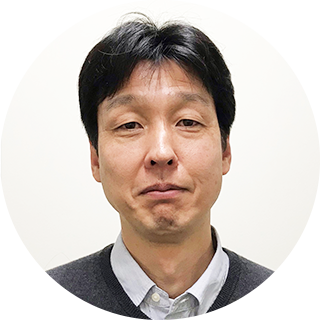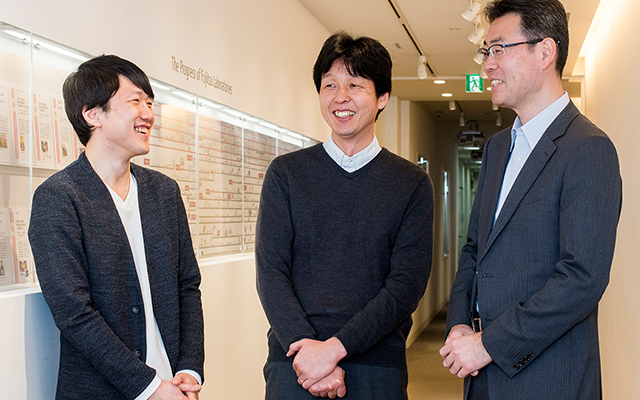Curing cancer is a top priority, and our Deep Tensor research team is working closely with clinical researchers to find new solutions. Our work together involves setting up tasks, evaluating and analyzing results, and demonstrating knowledge elicitation, all with the goal of finding a cure for cancer. During this collaborative research, a number of medical issues and technical problems have come to light, based on the actual extraction of findings from the gene network. We can honestly conclude that cancer treatment methods that analyze the behavior and targeting of individual genes have reached their limits. From now on, we need to develop effective cancer therapies based on an overall understanding of the network of regulatory relationships among genes.
Improving Health and Well-Being. New Cancer Treatments realized with Explainable AI "Deep Tensor" and Supercomputer Fugaku.
Japanese
Supporting people's wellbeing and realizing a healthier, longer-lived society is a cornerstone of Fujitsu’s research and development, across technologies that support the creation of value in society for each and every individual. In this article, we introduce how our explainable AI "Deep Tensor" and supercomputer Fugaku are supporting healthy living and creating a better future through cutting-edge technologies.
"I want to develop technologies that are highly effective and useful to people based on simple, eye-opening ideas." We asked Project Manager Koji Maruhashi, who has been working on AI development for many years both as a researcher and a manager, about his thoughts on medical applications that combine a number of our cutting-edge technologies. (Part 2 of a 2-part series. Click here to read the Part 1 )
Published on April 21, 2022
Researcher
-

Maruhashi, Koji
Project Manager
Discovery Mathematics Project
Artificial Intelligence Laboratory
Fujitsu Research
Collaborating with clinical researchers to improve people's health via new systems, including a cancer cure breakthrough
What are the principal medical challenges facing clinical researchers today?
What are the actual technical challenges to extracting knowledge from the gene network?
Each cancer patient has a different level of cancer progression. And the entire network of regulatory relationships among genes also changes significantly as the cancer progresses. Therefore, it is important to analyze changes in the structure of the entire network and to draw knowledge from it, rather than just focusing on changes in known genes. We believe that this will enable us to establish individualized treatment methods according to the progression of the cancer.
This must require a very wide knowledge base. Tell us about the drivers that led to the development of an explainable AI.
I was a life science major in college and studied a lot about genes. I was deeply interested in the evolution of regulatory relationship networks between genes. 20 years ago, I was involved in a specific R&D technology project for analyzing networks between genes. However, at that time, the technology for large-scale analysis of genes was in its infancy, and even though we could obtain a lot of data, there were limits to what we could learn from it. AI technology was not yet developed.
Although my research focus has since shifted away from genes, my interest in network analysis has continued, leading to the development of an explainable AI, "Deep Tensor" *1. As AI technology develops, ensuring the transparency and reliability of AI systems has become a major issue. It is important to have "explainable AI" that not only automatically makes decisions based on data, but also provides reasons for individual decisions. When developing AI, you need to address two considerations – using AI technology not only to make predictions but also to present the predicted results in an understandable way, so that doctors and other users can understand them. This is what led to the analysis of intergenic networks. Although there are difficulties unique to the medical field, I am motivated by the desire to "elucidate the complex mechanisms of life”.
- *1:Deep Tensor is a machine learning technology that is good at handling information represented as a shape with nodes connected by edges. It is a technology that enables existing deep learning technology, which has achieved extremely high recognition accuracy for images and voice, to be applied to data with a graph structure.
Fugaku enables high speed explainable AI-based cancer gene network analysis to elucidate cancer mechanisms.
What technology did you actually develop?
We have developed Deep Tensor, a technology that enables highly accurate predictions for data with a graph structure that can represent the connections between people and things. By applying Deep Tensor, we can extract the components in the graph structure that represent the reason behind a prediction.
Calculating regulatory relationships between some 20,000 human genes used to take several months even on the supercomputers available at universities and other research institutions. We have been able to transform this process. The analysis of a cancer gene network using Deep Tensor was completed in less than one day, using Fugaku's high-speed processing. *2
Being able rapidly to extract the components that enable highly accurate predictions has allowed us to proceed quickly to the next stage of the process. We can now allocate the time and effort to consider the entire vast gene network. While our results provide an important insight into the relationship between gene networks and epithelial cancer invasion/relocation, I believe that this is a good opportunity dramatically to reduce the amount of work physicians will have to do in the future to decide on treatment strategies.
What is your outlook for future AI development?
We would like to realize an AI that comprehensively understands how causal relationships among genes affect phenomena at various levels, such as molecules, cells, tissues, and organs, so that new treatments can be discovered. *3 Although we are currently targeting the medical field, we are also studying applications in other areas, such as fraud detection in the financial field.
I believe that there is still enormous potential for what we can do with huge networks of data. For example, it may be possible to gain a variety of insights from the patterns of people's daily activities. This is an exciting line of research, that I believe will benefit society in the future and that’s our motivation!
- *2:
- *3:




